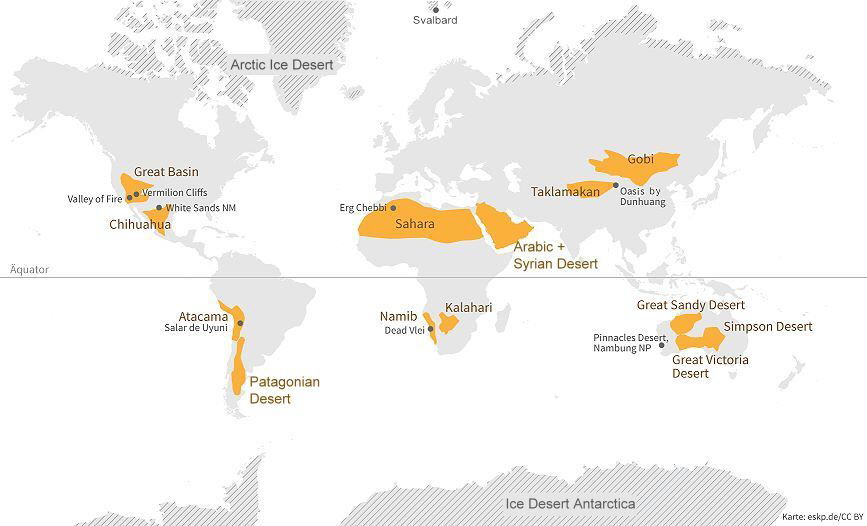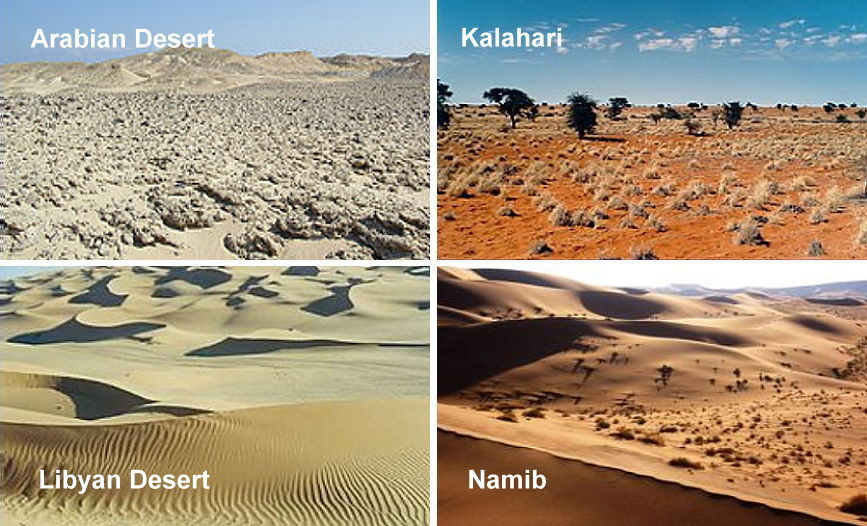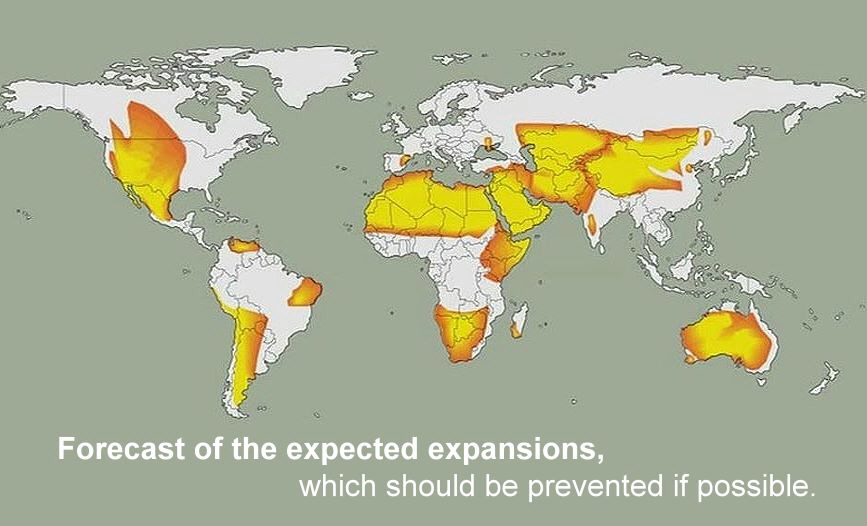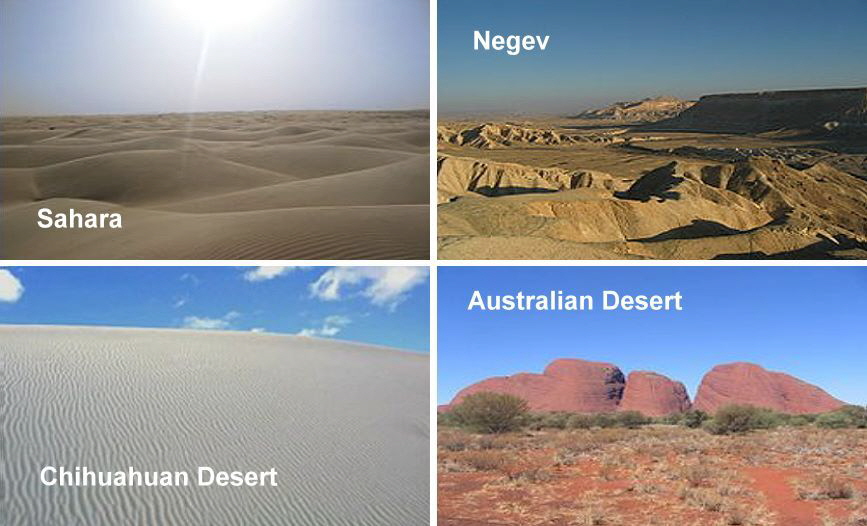

Index Home Desert-Electricity World Deserts Electric Network Types of Produktion Comparison Water Network Hydrogen New Industry Green Cities Energy Transition Imprint
World Deserts
As is well known, the earth is mainly covered by water. Of the surface area of 510 million square kilometers, only 29 percent, or 149 million square kilometers, is land area. Of this, around 33.6 percent of the land area or around 9.8 percent of the earth's total surface is desert or semi-desert. These deserts deserve our special attention, they need to be used, this use will solve our problems.


- In North America, 20 percent of the land area is desert
- In South America it is around 19 percent
- The deserts in Africa even cover 40 percent of the land area
- The deserts in Central Asia cover 37 percent of the land area there
- Australian deserts cover around 18 percent of the land area
These arid areas are also known as dry areas and are constantly expanding.


Temperatures and solar power of some of the deserts per year
- USA and Mexico: Some of the hottest regions in the world can be found here. Example Death Valley: here the air temperature is up to 57.2°C, in the sand even up to 95°C, the sun shines around 4500 hours of sunshine per year.
- Different values in summer: Nevada: over 40°C, 3700 hours of sunshine; Texas: up to 40°C, 3700 hours of sunshine; Phoenix, Arizona: ~ 38°C, 3872 hours of sunshine; Yuma, Arizona: also 38°C but up to 4015 hours of sunshine per year.
- Mojave Desert California: up to 28°C, around 3700 hours of sunshine per year.
- Chihuahua Desert: USA/Mexico border area, crossed by the Sierra Madre mountains: max. 35-40°C, around 3800 hours of sunshine per year
- Sonora Desert in Mexico: 3550 hours of sunshine, maximum temperature: between 23°C and 39°C. Hottest month: 39°C in June. Coldest month: 23°C in December.
- South America:
- In the Atacama, where it doesn't rain for years, maximum daily temperatures are 30°C for around 13.5 hours a day. So over 4500 hours a year.
- Africa:
- In the Libyan Desert the sun shines for around 4,300 hours a year and at a maximum temperature of up to 58°C.
- In the Sahara the sun shines for around 4,000 hours a year and the temperature can rise to over 55°C in the shade.
- In the Kalahari, temperatures reach up to 45°C in summer, whereas strong temperature gradients can be observed in winter. There can be severe frost at night, while temperatures can reach 25°C during the day. In total there are 4000 hours of sunshine.
- Middle East:
- Syrian Desert: Maximum temperature: between 11°C and 33°C, with around 3600 hours of sunshine
- Negev: During the day it can get up to 58°C, but at night it can cool down to -10°C. In total, the output is around 3,800 hours of sunshine per year.
- The Arabian Desert:
- In the summer months of April to October, temperatures rise to an average of 35°C to 43°C and often up to 50°C. Only in the winter months of November to March are temperatures usually between 25°C and 30°C. Spread over the year, there are up to 3,400 hours of sunshine per year.
- Cities there: Ajman: 35°C, 3,285 h; AL Fujayrah: 32.9°C, 2811 h; Ash Shaiqah: 34.3°C, 3249 h and Dubai: 34.5°C, 3322 h per year.
- Central Asia:
- In the Taklamakan it can be 62°C hot during the day and -12°C cold at night. Accordingly, temperatures fluctuate around 70°C throughout the day, with around 2,700 hours of sunshine per year.
- In the Gobi Desert, temperatures can rise to over 40°C on summer days, but can drop to -50°C on winter nights. On an annual average, the sun shines an average of 7.6 hours per day, i.e. around 2,500 hours per year.
- Large parts of Australia enjoy up to 3,000 hours of sunshine per year. Temperatures reach up to 50°C and rainfall is less than 250 millimeters per year.
Summer and winter, daily and nightly supply options
With these values you can easily imagine that enough power can be provided. Nevertheless, it will be a detailed computational work to determine how enough energy can be available in every region throughout the year, for 24 hours. But with an international energy network this will be easily possible. It will definitely be easier and much cheaper than if each country builds its own capacity. Of course, the entire development can also be accelerated extremely, if all countries in the world are now investing in this project and in this way poorer countries are not lagging behind in development. This brings enormous advantages for all sides. We also have to realize that this is about supplying people with energy and not about supplying a few shareholders with money.
Suitability of deserts for electrical energy production
Not all deserts are equally suitable for generating energy; sandy deserts in particular present potential generation plants with major challenges, but it is important to remember that we will only need a maximum of 2-5 percent of the area in order to be able to generate sufficient electrical energy. So we can choose the best places in which we want to set up systems.
The expansion of the deserts
The expansion of deserts is being accelerated extremely by the current global warming. The international energy network can also take countermeasures here, not only through a resulting reduction in CO2 emissions but also through the recultivation of desert areas, the creation of residential areas and agricultural areas through the provision of water. This can not only stop the expansion of the deserts but even reverse them develop. Every cultivation of areas, every major planting, binds water, water that is brought to these deserts with the help of the energy produced in the desert and will ensure flourishing landscapes there.
Index Home Desert-Electricity World Deserts Electric Network Types of Produktion Comparison Water Network Hydrogen New Industry Green Cities Energy Transition Imprint